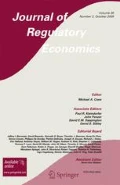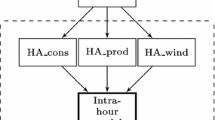Abstract
The primary purpose of this paper is to evaluate the benefits of distributed storage capacity in the form of deferrable demand managed centrally by a system operator, and in particular, to determine the savings in the total annual cost of supplying electricity for a system that has a substantial amount of variable generation from wind turbines. Since the objective of a centrally controlled system is to minimize the expected daily operating costs subject to the availability of generating units and storage capacity, the basic economic question is whether the savings in the annual system cost of supply, including the capital cost of installed generating capacity, can offset the capital cost of installing deferrable demand capacity. The analysis uses a new multi-period model of a power grid that treats stochastic generation explicitly and determines the optimum hourly commitment of conventional generators and the charging/discharging of deferrable demand needed to maintain the reliability of supply. A simulation example shows that deferrable demand can reduce system costs by (1) shifting demand from expensive peak periods to less expensive off-peak periods, (2) providing ramping services to mitigate the variability of wind generation, and (3) reducing the amount of installed peaking capacity needed for System Adequacy and the associated capital costs. If customers pay rates for electricity that reflect the true system costs of supplying their patterns of purchases from the grid, customers with deferrable demand will pay lower bills for electricity and their savings will be substantially more than the cost of installing deferrable demand devices. The results also show that if customers pay typical flat rates for electric energy, the economic incentives for installing deferrable demand are perverse.







Similar content being viewed by others
Notes
A stochastic multi-period security constrained AC OPF, co-optimizing endogenous reserves to provide ramping, mitigate wind variability and cover a set of credible contingencies.
In the case of the loads in New York City and Long Island, only 2006 data is used for estimation because the data for earlier years combined both regions together.
The model in (Jeon et al. 2015) also includes a price equation that is a function of the load but no clear evidence of simultaneity between price and load is found for the data used. It is likely, however, that this result would not hold up using more current data because demand response has now become much more important for operating electric grids.
Initial analyses simulated temperature, wind speed and load together but the variability of the simulated wind speed and load is unrealistically high. Hence, our procedure assumes implicitly that a system operator has a perfect forecast of temperature, but the inaccuracy of the forecasts of load and wind speed is large enough to be considered explicitly in determining the optimum day-ahead operations.
This is why forecasts 30 h ahead are computed. The actual number of leads and lags used is relatively small and it depends on the total capacity of the wind farm at a site.
An alternative approach would be to base the ranking and clustering on the total “net load” = total load\(-\)total PWG, but at this time, it has not been implemented.
These probabilities are actually shrunk even further to allow for low-probability contingencies to occur, and the sum of the transition probabilities into contingency states in hour t and the 25 transition probabilities for intact states from hour t to hour t +1 is equal to one.
This energy capacity is chosen to be equivalent to the usable battery capacity of a 10 % penetration of electric vehicles in New England and New York State. This type of deferrable demand is also an option of the SuperOPF but electric vehicles are not part of the analysis for this paper.
References
Allen, E., Lang, J., & Ilic, M. (2008). A combined equivalenced-electric, economic, and market representation of the Northeastern power coordinating council U.S. electric power system. IEEE Transactions on Power Systems, 23(3), 896–907.
CASE 07-M-0548 - Proceeding on motion of the commission regarding and energy efficiency portfolio: (Order issued and effective december 26, 2013). (2013). http://documents.dps.ny.gov/public/Common/ViewDoc.aspx?DocRefId=7705D91D-ACB8-4560-9984-D1545DDD2D0E
Castro, L. D., & Dutra, J. (2013). Paying for the smart grid, energy economics, 40, Supplement 1(0), S74–S84. Supplement issue: Fifth Atlantic workshop in energy and environmental economics. http://www.sciencedirect.com/science/article/pii/S0140988313002119
Chen, J., Mount, T. D., Thorp, J. S., & Thomas, R. J. (2005). Location-based scheduling and pricing for energy and reserves: A responsive reserve market proposal. Journal of Decision Support Systems, 40(3–4), 563–577.
Cuomo, A. (2014). Governor Cuomo announces fundamental shift in utility regulation, Technical report, State of New York, executive chamber. http://www.governor.ny.gov/press/04242014Utility-Regulation
EVAPCO. (2007). Thermal ice storage–application and design guide, Technical report , EVAPCO Inc.
EVFR (2012). FirstRate, Technical report, Energy visuals, Inc. www.energyvisuals.com.
Hunt, M., Heinemeier, K., Hoeschele, M., & Weitzel, E. (2010). HVAC energy efficiency maintenance study. CALMAC: Technical report.
Jeon, W., Mo, J. Y., & Mount, T. D. (2015). Developing a smart grid that customers can afford: The impact of deferrable demand. The Energy Journal, 36(4). http://www.iaee.org/en/publications/prejournal.aspx
Keane, A., Milligan, M., Dent, C. J., Hasche, B., D’Annunzio, C., Dragoon, K., et al. (2011). Capacity value of wind power. IEEE Transactions on Power Systems, 26(2), 564–572.
Kumar, N., Besuner, P. M., Lefton, S. A., Agan, D. D., & Hilleman, D. D. (2012). Power plant cycling costs, Technical report, Intertek APTECH. http://www.nrel.gov/docs/fy12osti/55433
Lamadrid, A. J., Mount, T., Jeon, W., & Lu, H. (2014). Barriers to increasing the role of demand resources in electricity markets. In System Sciences (HICSS), 2014 47th Hawaii International Conference on (pp. 2314–2324). IEEE.
Lew, D., Brinkman, G., Kumar, N., Besuner, P., Agan, D., & Lefton, S. (2012). Impacts of wind and solar on emissions and wear and tear of fossil-fueled generators, in power and energy society general meeting, 2012 IEEE, pp. 1–8.
Lew, D., Brinkman, G., Kumar, N., Lefton, S., Jordan, G., & Venkataraman, S. (2013). Finding flexibility: Cycling the conventional fleet. Power and Energy Magazine IEEE, 11(6), 20–32.
Lively, M. (2010). Short run marginal cost pricing for fast responses on the Smart Grid, in innovative smart grid technologies (ISGT), 2010, pp. 1–6.
Mount, T., & Lamadrid, A. J. (2010). Are existing ancillary service markets adequate with high penetrations of variable generation?, in PES general meetings, pp. 1–9.
Mount, T., Maneevitjit, S., Lamadrid, A., Thomas, B., & Zimmerman, R. (2012). The hidden system costs of wind generation in a deregulated electricity market. The Energy Journal, 33(1), 161–186.
Murillo-Sanchez, C., Zimmerman, R., Anderson, C., & Thomas, R. (2013). Secure planning and operations of systems with stochastic sources, energy storage, and active demand. IEEE Transactions on Smart Grid, 4(4), 2220–2229.
NERC (2010). Reliability standards for the bulk electric systems of North America, 116–390 Village Road, Princeton, NJ, 08540: North American Electric Reliability Corporation. http://www.nerc.com/files/Reliability_Standards_Complete_Set
Norgaard, P., & Hottlinen, H. (2004), A multi-turbine power curve approach, in Nordic wind power conference, http://www.ieawind.org/index.html, pp. 1–5
NREL. (2010). Eastern wind integration and transmission study, Technical report, EnerNex Corporation, The National Renewable Energy Laboratory, 1617 Cole Boulevard. Colorado: Golden. 80401.
Outhred, H. (1998). A review of electricity industry restructuring in Australia, Electric Power Systems Research, 44(1), 15–25. http://www.sciencedirect.com/science/article/B6V30-3TW320D-3/2/a8ca131ef5cd3be4694b3d40d706c402
Rahimi, F., & Ipakchi, A. (2010). Demand response as a market resource under the smart grid paradigm. IEEE Transactions on Smart Grid, 1(1), 82–88.
Zimmerman, R. D., Murillo-Sanchez, C. E., & Thomas, R. J. (2011). MATPOWER: Steady-state operations, planning, and analysis tools for power systems research and education. IEEE Transactions on Power Systems, 26(1), 12–19.
Acknowledgments
The authors would like to thank Ray D. Zimmerman, Carlos E. Murillo-Sanchez, Robert J. Thomas, Michael Crew and other participants at the Eastern and Western Rutgers Conferences organized by the Center for Research in Regulated Industries at the Rutgers Business School-Newark and New Brunswick for their comments and input. We also thank two anonymous reviewers for their constructive suggestions. This research was supported by the Lehigh Faculty Innovation Grant, the US Department of Energy through the Consortium for Electric Reliability Technology Solutions (CERTS), the Power Systems Engineering Research Center (PSERC), an NSF I/UCRC, and by NSF-Project 64581 “Cyber-Physical Energy Systems: Foundations for Smart Grids Supporting Intelligent Dependable Energy and Active Load.” The authors are responsible for all conclusions presented.
Author information
Authors and Affiliations
Corresponding author
Rights and permissions
About this article
Cite this article
Jeon, W., Lamadrid, A.J., Mo, J.Y. et al. Using deferrable demand in a smart grid to reduce the cost of electricity for customers. J Regul Econ 47, 239–272 (2015). https://doi.org/10.1007/s11149-015-9268-0
Published:
Issue Date:
DOI: https://doi.org/10.1007/s11149-015-9268-0




